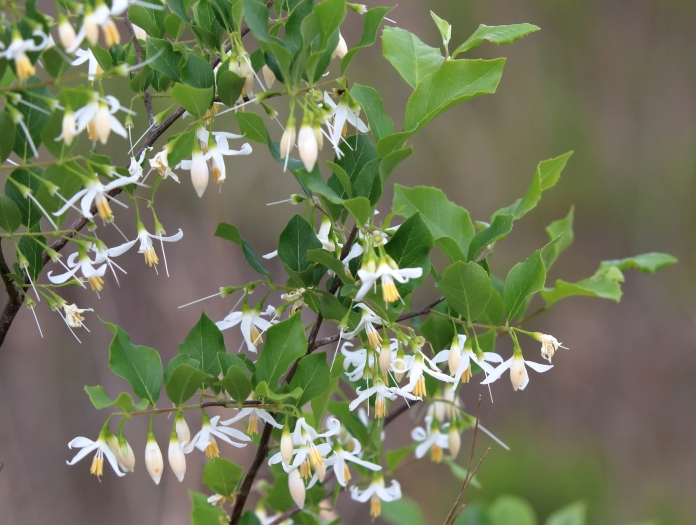American Snowbell
(Styrax americanus)
American Snowbell (Styrax americanus)
/
/

Lauren McLaurin
CC BY 4.0
Image By:
Lauren McLaurin
Recorded By:
Copyright:
CC BY 4.0
Copyright Notice:
Photo by: Lauren McLaurin | License Type: CC BY 4.0 | License URL: http://creativecommons.org/licenses/by/4.0/ | Rights Holder: Lauren McLaurin | Publisher: iNaturalist | Date Created: 2021-04-07T13:22:18-07:00 |


















































Estimated Native Range
Summary
Styrax americanus, commonly known as American Snowbell, is a deciduous shrub or small tree native to lowland woods, swamps, and along streams in the Southeastern United States. It typically grows to a height of 10 feet (3 meters) and a width of 6-10 feet (1.8-3 meters). American Snowbell features a rounded form with slender, spreading branches. It bears delicate, bell-shaped white flowers in late spring, which are quite showy and attract pollinators. The plant also produces a fruit that is a dry drupe, though it is not particularly ornamental.
American Snowbell is valued for its graceful appearance and the profusion of fragrant flowers that provide a display in the spring garden. It is often used in residential landscapes for naturalistic plantings and as an understory tree in woodland gardens. This species is relatively low-maintenance, tolerating a range of soil conditions, though it prefers moist, well-drained acidic soils. It can grow in full sun to part shade, with part shade being ideal in hotter climates to prevent stress. While generally pest-free, it can occasionally suffer from leaf spot or dieback. It is not known for aggressive roots or significant disease issues. American Snowbell is not typically invasive when grown outside its native range, but gardeners should always monitor and manage their plants responsibly.CC BY-SA 4.0
American Snowbell is valued for its graceful appearance and the profusion of fragrant flowers that provide a display in the spring garden. It is often used in residential landscapes for naturalistic plantings and as an understory tree in woodland gardens. This species is relatively low-maintenance, tolerating a range of soil conditions, though it prefers moist, well-drained acidic soils. It can grow in full sun to part shade, with part shade being ideal in hotter climates to prevent stress. While generally pest-free, it can occasionally suffer from leaf spot or dieback. It is not known for aggressive roots or significant disease issues. American Snowbell is not typically invasive when grown outside its native range, but gardeners should always monitor and manage their plants responsibly.CC BY-SA 4.0
Plant Description
- Plant Type: Tree, Shrub
- Height: 6-10 feet
- Width: 6-10 feet
- Growth Rate: Slow
- Flower Color: White
- Flowering Season: Spring
- Leaf Retention: Deciduous
Growth Requirements
- Sun: Full Sun, Part Shade
- Water: Medium
- Drainage: Fast, Medium
Common Uses
Bee Garden, Bird Garden, Border Plant, Butterfly Garden, Fragrant, Hummingbird Garden, Showy Flowers, Water Garden
Natural Habitat
Native to lowland woods, swamps, and along streams in the Southeastern United States
Other Names
Common Names: Mock Orange
Scientific Names: , Styrax americanus, Styrax americanus var. pulverulentus, Styrax pulverulentus, Styrax americanus var. americanus, Styrax laevigatum, Styrax americanus f. genuinus, Styrax americanus f. pulverulentus, Styrax americanus f. glaber, Styrax laevigatus
GBIF Accepted Name: Styrax americanus Lam.